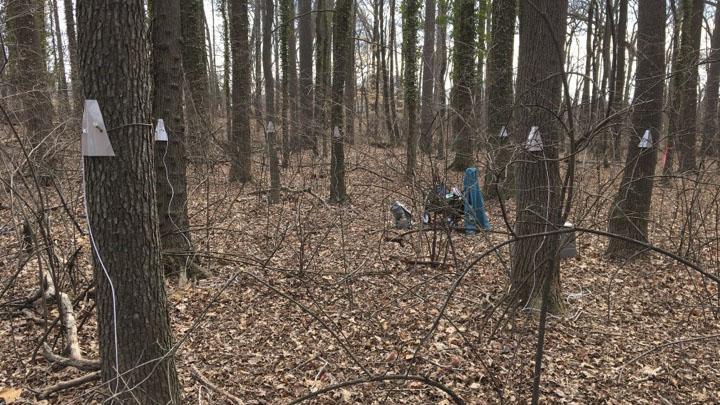Research finds landscape, number, and size of trees can change stormwater uptake more than 60 percentage points.
Street trees along a roadside in Gaithersburg, MD.
Image Credit: Tuana Phillips
A new study from UMD found that the amount of rainwater a tree absorbs varies dramatically depending on where it’s planted, and whether it is alone or with other trees. The finding is important because trees reduce rainwater runoff and improve and protect water quality. They play a key role in many urban stormwater management designs where conservation programs often give credits for planting urban trees and forests.
Understanding how different factors influence a tree’s ability to absorb rainwater is important for developing effective incentive programs and understanding the impact of these conservation efforts. The study was published in the journal Urban Forestry & Urban Greening and is a collaboration with researchers at the USFS Northern and Southern Research Stations and the non-profit Center for Watershed Protection.
Although scientists know a lot about how different tree species absorb water and the impact of varied conditions on water uptake, most of the data used for developing stormwater management plans comes from non-urban settings or arid cities like Los Angeles. Little is known about water absorption by trees in different urban settings, like in the Mid-Atlantic. This knowledge gap is especially important in the Chesapeake Bay region where five states are bound by U.S. Environmental Protection Agency laws to reduce rainwater runoff into waterways.
“We were partly surprised that there weren’t strong differences between species,” said Mitchell Pavao-Zuckerman, an associate professor in the Department of Environmental Science and Technology, and senior author of the study. “The differences really were more connected to the size of the trees, where larger trees basically had more capillary tissue to move water up through their trunks and into their canopies.”
The researchers were also surprised to discover that individual trees take up much more water when they are alone than when they are planted in a patch of other trees, even though clusters of trees absorb more total water--the way a cluster of drinking straws can draw more water than a single large-bore milkshake straw. This information means street trees and urban forests can be more accurately incorporated into the development and refining of stormwater management programs.

Such a detailed picture has not been previously available because it requires direct measurements with sensitive research equipment in complex urban environments. That’s why most studies have incorporated remote data and mathematical modeling. This is the first study to capture fine scale, direct measurements that show how the microclimate, tree species, and planting arrangements can influence water uptake in urban settings.
To capture data in the field, the researchers installed instruments in a forest patch, and turf locations in Baltimore and Montgomery County, MD. Their sites included a variety of tree species, sizes, densities and canopies. From June 2018 to October 2019, they measured environmental conditions such as temperature, rainfall, soil moisture and the density and amount of sap flowing through the trees, which they used to calculate how much water each tree took up and breathed out into the atmosphere.
They focused on three common urban tree species—Red Maple, Tulip Poplar, and Sweet Gum. Further research could build from the knowledge gained here to develop a more comprehensive database of water use by other common urban tree species in different management contexts.
The paper, “Interactions between management context and tree water use influence stormwater management potential of urban forests,” appeared in the May 2024 issue of the journal Urban Forestry & Urban Greening.
Additional authors from UMD include former graduate students from the Department of Environmental Science and Technology Sarah Ponte (PhD ‘22, now a Planner with the Washington State Department of Environment) and Tuana H. Phillips (MS ‘18, now an Environmental Protection Specialist at US Environmental Protection Agency).